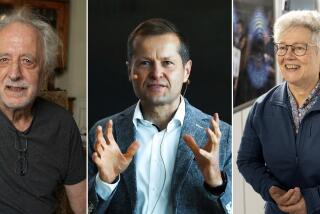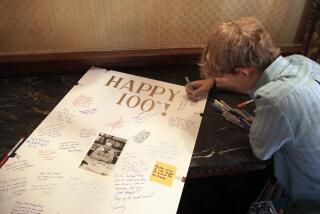Molecular Scientist Zips Along on Fast Track With Laser Study, Awards
- Share via
The speed of everything around him, compared to life in his native Egypt, stunned Ahmed Zewail the moment he landed in America.
“I think for five minutes I just had to stand there and absorb this whole new culture,” the Caltech professor of chemical physics said of that moment 20 years ago in a Philadelphia airport.
Now, with one major honor following another, Zewail is receiving international recognition for recording the formation and breaking of molecular bonds, a phenomenon that takes place so fast many scientists thought it could never be captured.
Zewail’s career is on a fast track. This spring, at 43, he was named to the prestigious National Academy of Sciences, whose members are usually in their mid-50s when they are chosen.
Academy membership came right on the heels of the 1989 King Faisal International Prize in Science, which Zewail received in Saudi Arabia for “pioneering and excellent work on ultra-fast laser chemistry.” Zewail received $100,000 along with the award.
Symbol of Success
In an interview between celebrations at Caltech in Pasadena, the ebullient Zewail theorized that his airport introduction to America was symbolic of his later success.
“It is because of this speed, this ability to move fast and cut through bureaucracy, that we can achieve quickly,” he said.
Colleagues say Zewail adds enthusiasm and excitement to painstaking work on projects that require years to complete. But they say that he is extremely cautious and insists on absolute proof before allowing any of the results from projects he supervises to be published.
Rudolph Marcus, Caltech professor of chemistry, called Zewail “fearless, and an outstanding scientist.”
“He has a good eye for important problems and is willing to do everything that has to be done to get a solution,” Marcus said.
Studies and Research
Zewail arrived at Caltech in 1976, after earning a bachelor’s degree at Alexandria University in Egypt and graduate degrees at the University of Pennsylvania and UC Berkeley, where he did postdoctoral work.
By 1985, he was able to predict his Caltech research team’s ability to “look at the moment of birth of a molecule.”
“A year later we saw it happen. It was a wonderful celebration,” he said, waving toward empty Champagne bottles that still decorate a corner of his office.
Describing his scientific achievement in family terms, Zewail said: “Molecules A and B meet, marry and beget the species. This takes place in one millionth of a billionth of a second. This is a fundamental process in nature, and the world was looking for a way to be able to see the process. But many brilliant people said it couldn’t be done.”
Laser-Captured Instant
Using a laser as if it were a camera, and recording the phenomena through the use of a computer, Zewail said the laser could record in millionths of a billionth of a second, which is called a femtosecond.
He described a femtosecond as equal to the time it takes light to travel one one-hundredth of the width of a human hair. Another analogy he uses is: “A femtosecond is comparable to one second in 32 million years. It is like watching a 32-million-year movie to see one second.”
The “marrying and birth” of molecules was recorded and proved repeatedly in his laboratory by a team working with him.
Richard Bernstein, a UCLA professor of chemistry and a member of the National Academy of Sciences, was a visiting scholar at Caltech working with Zewail’s research team when proof of the molecular action was recorded in 1986.
Bernstein said that, in applying laser physics to molecular bonding, Zewail was successful with “a concept that had been only a curiosity. He made it a useful tool.”
Mastering Molecules
“Once we understand how molecules are formed, we can manipulate them,” Zewail said. “If you can manipulate molecules you can manipulate genes and matter, you can synthesize new material--the implications are just unbelievable.”
Far from completing his project, Zewail said the breakthrough “establishes what we have to work on for five to 10 years, as we try to understand why molecules love each other and hate each other. There is a lot of analogy between molecules and humans, but they are perhaps smarter.”
Doctoral student Marcos Dantus said Zewail “gets very excited, and that definitely has an impact on science. He will come to the lab or will keep calling, even if it’s midnight, so you feel tremendous enthusiasm. And if we’re down he’ll give us a pep talk, like this is the most important thing in the world.”
That excitement, Dantus said, stems from Zewail’s “unusually strong intuition--his feeling that comes from having done all the necessary research. It’s an unusual characteristic for a scientist.”
Love for Science
Zewail traces his love for science to his family’s encouragement and to the Egyptian educational system, which gives a lot of support to scholars.
“The dream of my family was for me to be an educated person,” he said, describing a well-rounded childhood in Alexandria with three sisters, all of whom have college educations.
“Now I’m sort of a hero, and when I go there it’s in all the newspapers,” he said. “(Egyptians) see me as one of their people who can go to the United States and do something important and they are very, very proud.”
When he arrived to study at the University of Pennsylvania in 1969, he said, “I immediately saw the difference between Egypt and us. I was so impressed by the way things go so fast, without so much bureaucracy. There is this element of the importance of time.”
In his acceptance speech when he received the King Faisal prize, Zewail credited his success to his family, to Egypt for his excellent early education, to Caltech for creating a good scientific atmosphere, and to colleagues and the 78 graduate and postdoctoral students who have worked with him during his 13 years at Caltech.






